Download PDF
Download page Junctions and Flow Splits.
Junctions and Flow Splits
HEC-RAS 6.0 does not require user input to model sediment at junctions. Dendritic junctions, those with two upstream reaches and one downstream reach, simply combine sediment. Flow splits, junctions with one upstream reach and multiple downstream reaches, split the sediment of each grain class proportional to the flow split.
In order to select a different flow-split assumption at a junction, you will have to add the junction as a boundary condition. Press the Define Sediment Split at Junction button. ![]()
If the model has junctions that "split" (e.g. transition from one upstream reach to two-or-more downstream reaches), HEC-RAS will launch an editor with the junctions that it can add.
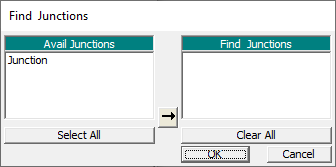
If the system is dendritic, (i.e. all reaches combine in the downstream direction so all junctions have only one downstream river/reach) HEC-RAS will not allow a junction split boundary condition. Pressing the Define Sediment Split at Junctions button for dendritic models (or single reach models) will return the following error: "There are no junctions with downstream flow splits in this geometry".
After adding a flow-split junction, click on the white field next to the junction name. The flow split options (the bottom row of the boundary conditions - see figure below) will become active.
Modeling Note: Side Channel Filling
Because sediment transport is non-linear (e.g. doubling the flow generally more than doubles the transport) flow splits tend to deposit. In particular, the lower flow channel tends to deposit quickly as the flow weighted sediment partition puts more sediment in the low flow channel relative to the transport than the higher flow channel. These theoretical considerations do translate to the field, as side channels tend to deposit. However, multi-dimensional effects and perched channels tend to keep prototype channels open longer than one-dimensional split flow models. If one channel downstream of a flow split fills unreasonably, consider modeling the flow split without the junction, using single cross sections to capture both channels. Multiple movable bed limits may also be helpful.Perched distributaries can pose another challenge to modeling flow splits. When the two downstream channels have different thalweg elevations, so most of the bed load follows one of the channels, a flow weighted split may not be appropriate for a perched distributary. Users sometimes model systems like this with lateral weirs (with grain class filters) instead of junctions. However, the current version of HEC-RAS includes grain class-specific flow split methods for junctions as well.
Flow Weighted Sediment Split 
This is the default calculation at a sediment split. Sediment flux in each reach is proportional to the flow. For example, if 80% of the flow goes into one reach and 20% into another, the sediment flux will have the same 80%/20% split for each grain class. If users do not add the junction to the sediment boundary condition editor, HEC-RAS will automatically split sediment this way. This feature is in the interface to help users toggle between methods and select the default without deleting the junction.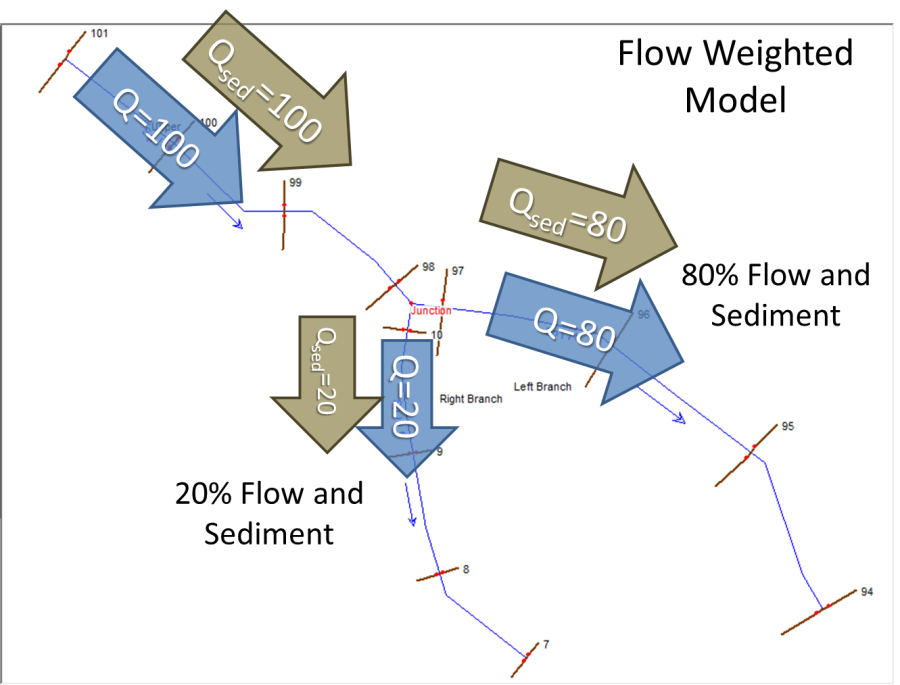
Potential Weighted Sediment Split 
Because sediment transport is non-linear, a distributary with more flow will transport disproportionately more sediment. Therefore, a flow-weighted split tends to overestimate sediment diverted to the lower-flow distributary, which can cause the lower flow reach to deposit quickly.
The potential weighted sediment split addresses this issue, computing the sediment split based on the computed transport potential instead of the flow. Figure 1 71 reproduces the example in Figure 1 70 with a simple transport potential (Gs) equation (Gs=0.01Q2) to illustrate the potential weighted approach.
Because of the non-linearity (i.e. power function) of the sediment transport potential equation, the 80%/20% flow split does not produce the same capacity split. The larger tributary has 94% of the capacity (Gs=0.001(80)2=64~94%) while the smaller tributary only has 6% of the capacity (Gs=0.001(20)2=4~6%).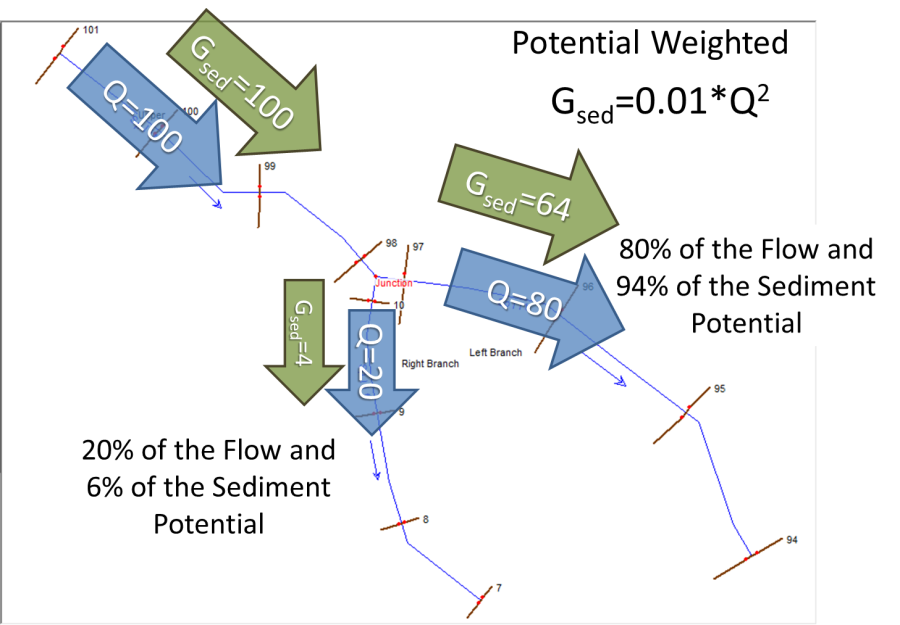
The potential weighted split divides sediment based on the percentage of the potential in all downstream reaches, instead of the flow. Another feature of the non-linear transport equations also emerges from this example. The sum of the potential in the two downstream reaches is less than the potential in the upstream reach (64+4<100). This is a function of the non-linear transport equations and is one of the reasons most sediment models will deposit downstream of a flow split. The combined flow has more transport potential. But splitting the flow based on potential rather than flow can slow this process and make the model more realistic.
Flow Weighted Split with a Grain Class Threshold 
This feature works like the grain class threshold option associated with lateral structures. This feature applies a flow weighted split for all grain classes less than a user specified threshold and sends 100% of the sediment greater than that threshold down the main reach (the reach with the same "River" name). This feature is designed to send suspended or wash load into a perched distributary while keeping bed load in the main channel.
HEC-RAS uses the "River" designation to determine the main and secondary channels. HEC-RAS will check the River names downstream of the junction. The reach that has the same river name downstream of the junction is considered the main channel. The threshold keeps sediment smaller than (or equal to) the defined grain class in the main channel and only allows finer grain classes in the side channel.
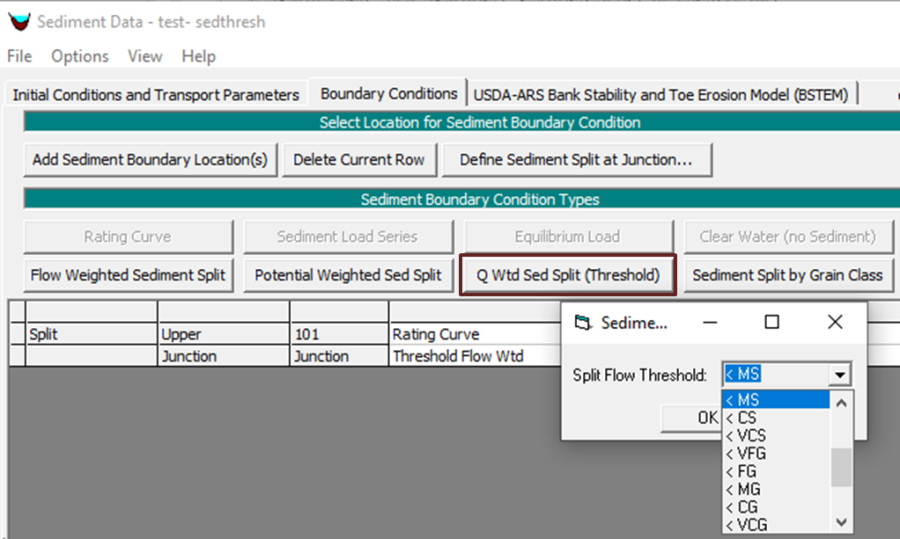
Sediment Splits by Grain Class 
This feature works like the diversion rating curve boundary condition. This method monitors the flow leaving the flow split. The user can choose a diverted sediment mass associated with each flow to specify the flow-load split directly. But the load split is optional. Leaving the Div Load row blank triggers a standard flow weighted split, and then adjusts each grain class individually from the base flow-weighted assumptions.
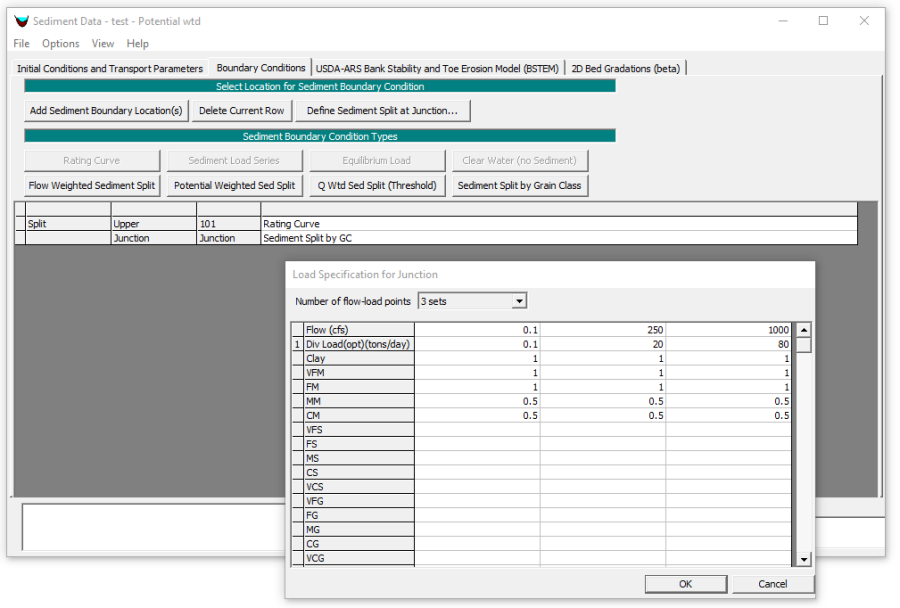
The Sediment Split by Grain Class tool then adjusts the sediment load for each grain class, from the initial value computed from the user specified or flow-weighted load. Specify a multiplier between zero and one to reduce the diverted sediment for each grain class.
For example, defining a factor of 0.5 for Very Fine Sand will half the diverted very fine sand and will send the other half in the main downstream channel. So in the example in the figure, 20 tons per day (combined for all grain classes) would be diverted to the distributary when the distributary flow is 250 cfs if the ratio for all grain classes was 1. Clay, very fine silt (MM), and fine silt (FM) will be diverted in their entirety. However, only half the computed medium silt (MM) and coarse silt (CM) fractions will divert, and nothing coarser than coarse silt will be diverted (because the fields are blank, entering zero in these fields would have the same result.